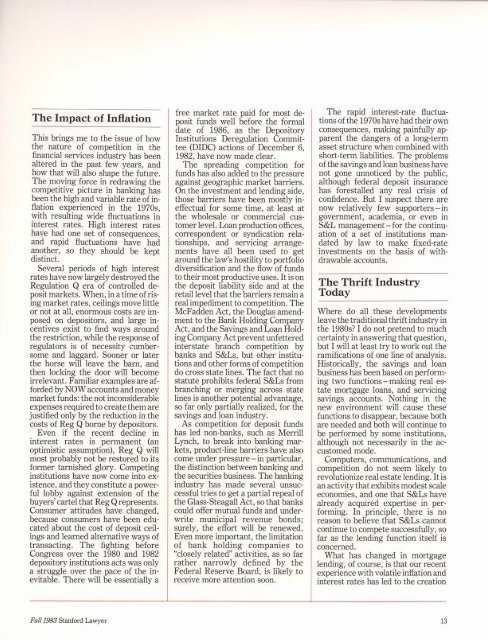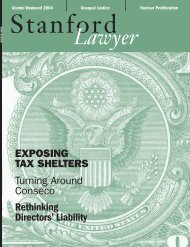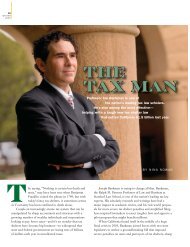that, because of regulation, cannotdo so. This means that geographicmarket barriers created by law aregoing to come under ever-increasingcost pressure; it would indeed befoolish to rely on them in the future.Second, the new technology affordsfar more flexible, convenient,and economical means of deliveringfinancial services than the longtraditionalset of branch offices andteller lines. Investment in branchoffices is being made obsolete, andoffice capacity will undergo continuingreduction. EFT terminals willproliferate, and the inappropriatenessof treating terminals asbranches for various legal purposeswill become more obvious. It is sensiblefor financial institutions toshare terminals and networks on avoluntary basis in some circumstances,but mandatory sharingstatutes are anticompetitive andmay be invalid under the antitrustlaws.But more fundamentally, the newmodes of delivering financial servicesare enabling households tobecome much better managers oftheir assets and liabilities. The costin time and inconvenience to customersof smoothing out their cashflows, shifting funds among investmentswith different degrees ofliquidity and risk, and obtaining andpaying offcredit lines is all decliningsharply. In such an environment, itmakes very little sense for financialinstitutions to be arbitrarily defined,or confined, in terms of the productsthey offer. There are areas in whichspecialization has its virtues, butthese do not include having one institutionoffer checking accounts,another savings accounts, and athird money funds. That world isending, and it is not a cause forregret.The world that is replacing it willbe marked by new financial servicepackages that tie together variousservices, so they can be more economicallyproduced and consumed.What those efficient combinationsare, or will be, is not easy to discern.We are now witnessing a process ofexploration, which undoubtedly haselements of trial and error about it.Traditional industry lines are beingbroken ever more frequently, as therecent history of financial acquisitionsmakes evident. A life insurancecompany (Prudential) acquires alarge securities brokerage firm(Bache), as does a leading creditcardcompany (American Expressand Shearson). A major retailer(Sears), which already owns an insurancecompany (Allstate) and asavings and loan association (AllstateSavings), buys a securities firm(Dean Witter) and a real estatebroker (Coldwell Banker). A giantbank (Bank of America) acquires aleading discount broker (CharlesSchwab). And so on.Several observations may l:ie offeredon this process of servicerepackaging. To begin with, most ofthe impetus is coming from outsidethe banking industry, which is partof the price of the present system ofbank regulation. Entrants from lessregulatedkinds of businesses havethe edge in responding to new tech- -nology and new opportunities. Theconsumer of banking services caresvery little whether the services comefrom an institution called a bank, solong as his needs are met in a waysuperior to other sources. One of thefew advantages that savings andloan associations have in this competitionis that they are not subject toregulation as banks or bank holdingcompanies by the Federal ReserveBoard, and that is no small boon.For another point, it is not apparentthat all these packages will bewinners. Banks obviously now believethat gains can be made by combiningdeposit services and securitiesservices; and it is true that bothinvolve the processing of massivetransactions volumes and a fairly frequentinterflow of funds. But arethere equally plausible reasons forbelieving that the combination of lifeinsurance and securities businessaffords major production economiesor consumption cOl).venience?One should also question the conclusionthat, whatever the gainsfrom certain packages, they are bestachieved by acquisitions leading tointegrated firms. One alternative iscooperative arrangements betweenseparate firms. Merrill Lynch, for instance,offers its Cash ManagementAccount through contractual relationshipswith Bank One in Ohio.There is also the even more importantalternative of packaging entrepreneurs- firms that assembledifferent services from specializedproducers and offer them to retail institutionsfor sale to the public.Nonetheless, the overall pointseems clear. The financial service industryis being restructured, and theold modes of business have limitedprospects for successful survival.Broader and more flexible productlines, rendered possible by advancesin computer and communicationstechnology, are going to dominatethe new financial services environment-a development that existinglegal obstacles may impede but cannotprevent.12<strong>Stanford</strong> <strong>Lawyer</strong> <strong>Fall</strong> <strong>1983</strong>
The Impact of InflationThis brings me to the issue of howthe nature of competition in thefinancial services industry has beenaltered in the past few years, andhow that will also shape the future.The moving force in redrawing thecompetitive picture in banking hasbeen the high and variable rate of inflationexperienced in the 1970s,with resulting wide fluctuations ininterest rates. lIigh interest rateshave had one set of consequences,and rapid fluctuations have hadanother, so they should be keptdistinct.Several periods of high interestrates have now largely destroyed theRegulation Q era of controlled depositmarkets. When, in a time of risingmarket rates, ceilings move littleor not at all, enormous costs are imposedon depositors, and large incentivesexist to find ways aroundthe restriction, while the response ofregulators is of necessity cumbersomeand laggard. Sooner or laterthe horse will leave the barn, andthen locking the door will becomeirrelevant. Familiar examples are affordedby NOW accounts and moneymarket funds: the not inconsiderableexpenses required to create them arejustified only by the reduction in thecosts of Reg Qborne by depositors.Even if the recent decline ininterest rates is permanent (anoptimistic assumption), Reg Q willmost probably not be restored to itsformer tarnished glory. Competinginstitutions have now come into existence,and they constitute a powerfilllobby against extension of thebuyers' cartel that Reg Qrepresents.Consumer attitudes have changed,because consumers have been educatedabout the cost of deposit ceilingsand learned alternative ways oftransacting. The fighting beforeCongress over the 1980 and 1982depository institutions acts was onlya struggle over the pace of the inevitable.There will be essentially afree market rate paid for most depositfunds well before the formaldate of 1986, as the DepositoryInstitutions Deregulation Committee(DIDC) actions of December 6,1982, have now made clear.The spreading competition forfunds has also added to the pressureagainst geographic market barriers.On the investment and lending side,those barriers have been mostly ineffectualfor some time, at least atthe wholesale or commercial customerlevel. Loan production offices,correspondent or syndication relationships,and servicing arrangementshave all been used to getaround the law's hostility to portfoliodiversification and the flow of fundsto their most productive uses. It is onthe deposit liability side and at theretail level that the barriers remain areal impediment to competition. TheMcFadden Act, the Douglas amendmentto the Bank lIolding CompanyAct, and the Savings and Loan lIoldingCompany Act prevent unfetteredinterstate branch competition bybanks and S&Ls, but other institutionsand other forms of competitiondo cross state lines. The fact that nostatute prohibits federal S&Ls frombranching or merging across statelines is another potential advantage,so far only partially realized, for thesavings and loan industry.As competition for deposit fundshas led non-banks, such as MerrillLynch, to break into banking markets,product-line barriers have alsocome under pressure- in particillar,the distinction between banking andthe securities business. The bankingindustry has made several unsuccessfultries to get a partial repeal ofthe Glass-Steagall Act, so that bankscould offer mutual funds and underwritemunicipal revenue bonds;surely, the effort will be renewed.Even more important, the limitationof bank holding companies to"closely related" activities, as so farrather narrowly defined by theFederal Reserve Board, is likely toreceive more attention soon.The rapid interest-rate fluctuationsof the 1970s have had their ownconsequences, making painfully apparentthe dangers of a long-termasset structure when combined withshort-term liabilities. The problemsof the savings and loan business havenot gone unnoticed by the public,although federal deposit insurancehas forestalled any real crisis ofconfidence. But I suspect there arenow relatively few supporters-ingovernment, academia, or even inS&L management- for the continuationof a set of institutions mandatedby law to make fixed-rateinvestments on the basis of withdrawableaccounts.The Thrift IndustryTodayWhere do all these developmentsleave the traditional thrift industry inthe 1980s? I do not pretend to muchcertainty in answering that question,but I will at least try to work out theramifications of one line of analysis.lIistorically, the savings and loanbusiness has been based on performingtwo functions - making real estatemortgage loans, and servicingsavings accounts. Nothing in thenew environment will cause thesefunctions to disappear, because bothare needed and both will continue tobe performed by some institutions,although not necessarily in the accustomedmode.Computers, communications, andcompetition do not seem likely torevolutionize real estate lending. Itisan activity that exhibits modest scaleeconomies, and one that S&Ls havealready acquired expertise in performing.In principle, there is noreason to believe that S&Ls cannotcontinue to compete successfully, sofar as the lending function itself isconcerned.What has changed in mortgagelending, of course, is that our recentexperience with volatile inflation andinterest rates has led to the creation<strong>Fall</strong> <strong>1983</strong> <strong>Stanford</strong> <strong>Lawyer</strong>13
- Page 1 and 2: RFAll 1983VOL. 18, NO.1Heroin Optio
- Page 3 and 4: jah(e,oYCONTENTSSTANFORD lAWYEREdit
- Page 5 and 6: Business Law vs. Public Interest La
- Page 7 and 8: By John Kaplanjockson Eli ReynoldsP
- Page 9 and 10: maintenance almost entirely up toth
- Page 11: smaller percentage of British addic
- Page 16 and 17: of a whole variety of new mortgagei
- Page 18 and 19: ConversationsWith Five AlumniBy Mic
- Page 20 and 21: y landlords and tenants about rents
- Page 22 and 23: when I was studying law and she was
- Page 24 and 25: ~o(1)AtISSUE *Union 'Rights' in the
- Page 26 and 27: AtISSUECongressional Responses toSu
- Page 28 and 29: AtISSUEPrison Labor:TimeTo Take Ano
- Page 30 and 31: Graduates and friends of theSchool
- Page 32 and 33: ~o~ 4'-VVcYi~STATE OF THE SCHOOLJoh
- Page 34 and 35: ~o~ Cff-VIMtu'0r-STATE OF THE SCHOO
- Page 36 and 37: ~o~ 4-(/141~STATE OF THE SCHOOL con
- Page 38 and 39: ~o~4VJ41~SUCCESSFUL LAWYERING:IMPLI
- Page 40 and 41: ~o~of-VJM~SUCCESSFUL LAWYERING cont
- Page 42 and 43: @.oarcA 4l!141~THE CONSTITUTION, RA
- Page 44 and 45: @o~4t1J41~.LAW AND BUSINESS PROGRAM
- Page 46 and 47: @otwrA 4vJ41~ .SUMMARY AND ADVISORY
- Page 48 and 49: David L. Engel(Harvard, JD '73)Bost
- Page 50 and 51: New Faculty (cont.)Michigan Law Sch
- Page 52 and 53: GILSON (cant.)Gilson is currently p
- Page 54 and 55: BabcockAwarded anHonorary LL.D.by S
- Page 56 and 57: CAREER 'ALTERNATIVES' (cant.)2. A s
- Page 58 and 59: Hurlbut WinnerTalks AboutTeachingPr
- Page 60 and 61: Schod;NI Grads Scatter toCities All
- Page 62 and 63: FACULTV NOTES (cant.) Professor Gun
- Page 64 and 65:
it will be less so if we adopt a he
- Page 66 and 67:
than on its edges, thus increasing
- Page 68 and 69:
Heroin maintenance is, in manyways,
- Page 70 and 71:
c~OTESII1912-25Hon. David Lee Rosen
- Page 72 and 73:
c~NOTESthe firm advises, that "Donn
- Page 74 and 75:
c~NOTESand had been prominent in a
- Page 76 and 77:
spring Dean Ely traveledLEast, wher
- Page 78 and 79:
5Stanford LaWlers:This Page IsYours
- Page 80 and 81:
October 11Washington, DC LawSociety
- Page 82 and 83:
COMPARATIVE CONTRIBUTIONS TOTHE LAW
- Page 84 and 85:
A MESSAGE FROM THELAW FUND PRESIDEN
- Page 86 and 87:
CLASSAGENTSLong BeachSterling S. Cl
- Page 88 and 89:
Warren Christopher'49 Penny Howe Ga
- Page 90 and 91:
Frank L. Mallory '47Richard C. Mall
- Page 92 and 93:
Ronald G. Trayner '67Anthony J. Tre
- Page 94 and 95:
Walter A. Johnson, A.B. '29 Maxine
- Page 96 and 97:
DONORS TO THE LAW FUND• Hon. Murr
- Page 98 and 99:
CLASS OF 1948R. Winfield AchorHon.
- Page 100 and 101:
• Thomas R. MitchellR. Chandler M
- Page 102 and 103:
Paul E. Kreutz• Prof. Richard B.
- Page 104 and 105:
Gabriel M. GesmerMichael GilfixCorn
- Page 106 and 107:
HIGHEST LEVELSOF PARTICIPATIONLARGE
- Page 108 and 109:
FACULTY, FORMERFACULTY &STAFFBarbar
- Page 110 and 111:
REUNION GIVINGWhile class reunions
- Page 112 and 113:
DONORS TO SPECIALPROGRAMS AND FUNDS
- Page 114 and 115:
Class of 1954 Reunion Student Finan
- Page 116 and 117:
In Memory of:Clifton C. Cottrell '2
- Page 118 and 119:
Clyde E. Tritt'49William W. VaughnS
- Page 120:
BEQUESTS AND DEFERRED GIVINGBequest
















